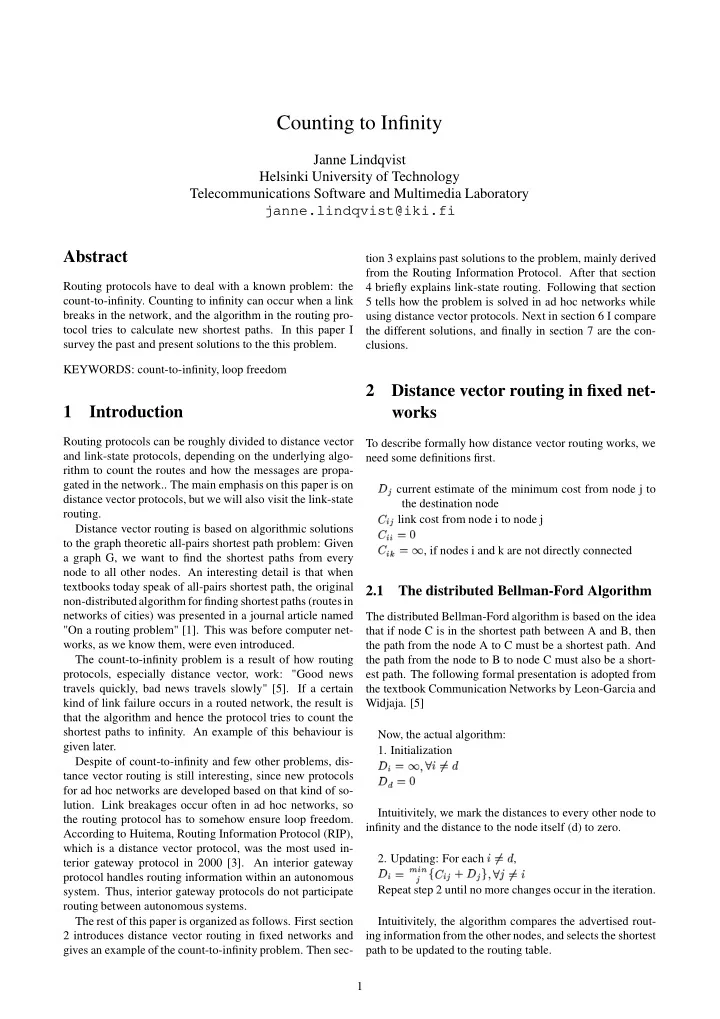

� � ✄ Counting to Infinity Janne Lindqvist Helsinki University of Technology Telecommunications Software and Multimedia Laboratory janne.lindqvist@iki.fi Abstract tion 3 explains past solutions to the problem, mainly derived from the Routing Information Protocol. After that section Routing protocols have to deal with a known problem: the 4 briefly explains link-state routing. Following that section count-to-infinity. Counting to infinity can occur when a link 5 tells how the problem is solved in ad hoc networks while breaks in the network, and the algorithm in the routing pro- using distance vector protocols. Next in section 6 I compare tocol tries to calculate new shortest paths. In this paper I the different solutions, and finally in section 7 are the con- survey the past and present solutions to the this problem. clusions. KEYWORDS: count-to-infinity, loop freedom 2 Distance vector routing in fixed net- 1 Introduction works Routing protocols can be roughly divided to distance vector To describe formally how distance vector routing works, we and link-state protocols, depending on the underlying algo- need some definitions first. rithm to count the routes and how the messages are propa- �✂✁ current estimate of the minimum cost from node j to gated in the network.. The main emphasis on this paper is on distance vector protocols, but we will also visit the link-state the destination node ✁ link cost from node i to node j ✄✆☎ routing. ✄✆☎✝☎✟✞✡✠ Distance vector routing is based on algorithmic solutions ✞✍✌ to the graph theoretic all-pairs shortest path problem: Given ☎☞☛ , if nodes i and k are not directly connected a graph G, we want to find the shortest paths from every node to all other nodes. An interesting detail is that when textbooks today speak of all-pairs shortest path, the original 2.1 The distributed Bellman-Ford Algorithm non-distributedalgorithm for finding shortest paths (routes in networks of cities) was presented in a journal article named The distributed Bellman-Ford algorithm is based on the idea "On a routing problem" [1]. This was before computer net- that if node C is in the shortest path between A and B, then works, as we know them, were even introduced. the path from the node A to C must be a shortest path. And The count-to-infinity problem is a result of how routing the path from the node to B to node C must also be a short- protocols, especially distance vector, work: "Good news est path. The following formal presentation is adopted from travels quickly, bad news travels slowly" [5]. If a certain the textbook Communication Networks by Leon-Garcia and kind of link failure occurs in a routed network, the result is Widjaja. [5] that the algorithm and hence the protocol tries to count the shortest paths to infinity. An example of this behaviour is Now, the actual algorithm: given later. 1. Initialization ☎✎✞✏✌✒✑✔✓✖✕✘✗ ✞✡✙ Despite of count-to-infinity and few other problems, dis- �✛✚ ✞✍✠ tance vector routing is still interesting, since new protocols for ad hoc networks are developed based on that kind of so- lution. Link breakages occur often in ad hoc networks, so Intuitivitely, we mark the distances to every other node to the routing protocol has to somehow ensure loop freedom. infinity and the distance to the node itself (d) to zero. According to Huitema, Routing Information Protocol (RIP), which is a distance vector protocol, was the most used in- ✞✍✙ , ✕✜✗ 2. Updating: For each ☎✝✤ terior gateway protocol in 2000 [3]. An interior gateway ☎✎✞✣✢ ✄✧☎ ✁✆★✩�✂✁✫✪ ✑✬✓✮✭✯✗ ✞✡✕ ✁✦✥ protocol handles routing information within an autonomous Repeat step 2 until no more changes occur in the iteration. system. Thus, interior gateway protocols do not participate routing between autonomous systems. The rest of this paper is organized as follows. First section Intuitivitely, the algorithm compares the advertised rout- 2 introduces distance vector routing in fixed networks and ing information from the other nodes, and selects the shortest gives an example of the count-to-infinity problem. Then sec- path to be updated to the routing table. 1
Recommend
More recommend